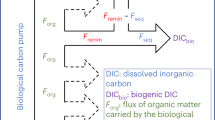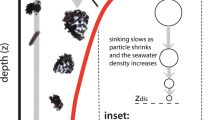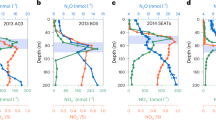Abstract
As particulate organic carbon rains down from the surface ocean it is respired back to carbon dioxide and released into the ocean’s interior. The depth at which this sinking carbon is converted back to carbon dioxide—known as the remineralization depth—depends on the balance between particle sinking speeds and their rate of decay. A host of climate-sensitive factors can affect this balance, including temperature1, oxygen concentration2, stratification, community composition3,4 and the mineral content of the sinking particles5. Here we use a three-dimensional global ocean biogeochemistry model to show that a modest change in remineralization depth can have a substantial impact on atmospheric carbon dioxide concentrations. For example, when the depth at which 63% of sinking carbon is respired increases by 24 m globally, atmospheric carbon dioxide concentrations fall by 10–27 ppm. This reduction in atmospheric carbon dioxide concentration results from the redistribution of remineralized carbon from intermediate waters to bottom waters. As a consequence of the reduced concentration of respired carbon in upper ocean waters, atmospheric carbon dioxide is preferentially stored in newly formed North Atlantic Deep Water. We suggest that atmospheric carbon dioxide concentrations are highly sensitive to the potential changes in remineralization depth that may be caused by climate change.
This is a preview of subscription content, access via your institution
Access options
Subscribe to this journal
Receive 12 print issues and online access
$259.00 per year
only $21.58 per issue
Buy this article
- Purchase on Springer Link
- Instant access to full article PDF
Prices may be subject to local taxes which are calculated during checkout




Similar content being viewed by others
References
Matsumoto, K. Biology-mediated temperature control on atmospheric pCO2 and ocean biogeochemistry. Geophys. Res. Lett. 34, L20605 (2007).
Devol, A. H. & Hartnett, H. E. Role of the oxygen-deficient zone in transfer of organic carbon to the deep ocean. Limnol. Oceanogr. 46, 1648–1690 (2001).
Klaas, C. & Archer, D. E. Association of sinking organic matter with various types of mineral ballast in the deep sea: Implications for the rain ratio. Glob. Biogeochem. Cycles 16, 1116 (2002).
Francois, R., Honjo, S., Krishfield, R. & Manganini, S. Factors controlling the flux of organic carbon to the bathypelagic zone of the ocean. Glob. Biogeochem. Cycles 16, 1087 (2002).
Armstrong, R. A., Lee, C., Hedges, J. I., Honjo, S. & Wakeham, S. G. A new, mechanistic model for organic carbon fluxes in the ocean based on the quantitative association of POC with ballast minerals. Deep-Sea Res. II 49, 219–236 (2001).
Martin, J. H., Knauer, G. A., Karl, D. M. & Broenkow, W. W. VERTEX: Carbon cycling in the northeast Pacific. Deep-Sea Res. 34, 267–285 (1987).
Yamanaka, Y. & Tajika, E. The role of the vertical fluxes of particulate organic matter and calcite in the ocean carbon cycle: Studies using an ocean biogeochemical general circulation model. Glob. Biogeochem. Cycles 10, 361–382 (1996).
Kwon, E. Y. & Primeau, F. Optimization and sensitivity of a global biogeochemistry ocean model using combined in situ DIC, alkalinity, and phosphate data. J. Geophys. Res. 113, C08011 (2008).
Kwon, E. Y. & Primeau, F. Optimization and sensitivity study of a biogeochemistry ocean model using an implicit solver and in situ phosphate data. Glob. Biogeochem. Cycles 20, GB4009 (2006).
Buesseler, K. O. & Boyd, P. W. Shedding light on processes that control particle export and flux attenuation in the twilight zone of the open ocean. Limnol. Oceanogr. 54, 1210–1232 (2009).
Berelson, W. POC fluxes into the ocean interior: A comparison of 4 US-JGOFS regional studies. Oceanography 14, 59–67 (2001).
Buesseler, K. O. et al. Revisiting carbon flux through the ocean’s twilight zone. Science 316, 567–570 (2007).
Lutz, M., Dunbar, R. & Caldeira, K. Regional variability in the vertical flux of particulate organic carbon in the ocean interior. Glob. Biogeochem. Cycles 16, 1037 (2002).
Conte, M., Ralph, N. & Ross, E. H. Seasonal and interannual variability in deep ocean particle fluxes at the oceanic flux program (OFP)/Bermuda Atlantic Time Series (BATS) site in the western Sargasso Sea near Bermuda. Deep-Sea Res. II 48, 1471–1505 (2001).
Sarmiento, J. L., Hughes, T. M. C., Stouffer, R. J. & Manabe, S. Simulated response of the ocean carbon cycle to anthropogenic climate warming. Nature 393, 245–249 (1998).
Broecker, W. S. The great ocean conveyor. Oceanography 4, 89–89 (1991).
Williams, R. G., Roussenov, V. & Follows, M. J. Nutrient streams and their induction into the mixed layer. Glob. Biogeochem. Cycles 20, GB1016 (2006).
Primeau, F. Characterizing transport between the surface mixed layer and the ocean interior with a forward and adjoint global ocean transport model. J. Phys. Oceanogr. 35, 545–564 (2005).
Ito, T. & Follows, M. J. Preformed phosphate, soft tissue pump and atmospheric CO2 . J. Mar. Res. 63, 813–839 (2005).
Marinov, I., Follows, M. J., Gnandesikan, A., Sarmiento, J. L. & Slater, R. D. How does ocean biology affect atmospheric pCO2? Theory and models. J. Geophys. Res. 113, C07032 (2008).
Gruber, N. & Sarmiento, J. L. in The Sea (eds Robinson, A. R., McCarthy, J. J. & Rothschild, B. J.) 337–399 (Wiley, 2002).
Marinov, I., Gnanadesikan, A., Toggweiler, I & Sarmiento, J. L. The southern ocean biogeochemical divide. Nature 441, 964–967 (2006).
Boyle, E. A. Vertical oceanic nutrient fractionation and glacial/interglacial CO2 cycles. Nature 331, 55–56 (1988).
Jaccard, S. L. et al. Subarctic Pacific evidence for a glacial deepening of the oceanic respired carbon pool. Earth Planet. Sci. Lett. 277, 156–165 (2008).
Marchitto, T. M. & Broecker, W. S. Deep water mass geometry in the glacial Atlantic Ocean: A review of constraints from the paleonutrient proxy Cd/Ca. Geochem. Geophys. Geosyst. 7, Q12003 (2006).
Mahowald, N. et al. Dust sources and deposition during the Last Glacial Maximum and current climate: A comparison of model results with paleodata from ice cores and marine sediments. J. Geophys. Res. 104, 15895–15916 (1999).
Sigman, D. M., McCorkle, D. C. & Martin, W. R. The calcite lysocline as a constraint on glacial/interglacial low-latitude production changes. Glob. Biogeochem. Cycles 12, 409–427 (1998).
Archer, D., Winguth, A., Lea, D. & Mahowald, N. What caused the glacial/interglacial atmospheric pCO2 cycles? Rev. Geophys. 38, 159–189 (2000).
Najjar, R. G. et al. Impact of circulation on export production, dissolved organic matter, and dissolved oxygen in the ocean: Results from phase II of the ocean carbon-cycle model intercomparison project (OCMIP-2). Glob. Biogeochem. Cycles 21, GB3007 (2007).
Brewer, P. G., Wong, G. T. F., Bacon, M. P. & Spencer, D. W. An oceanic calcium problem? Earth Planet. Sci. Lett. 26, 81–87 (1975).
Acknowledgements
We thank E. Galbraith and R. Toggweiler for their valuable comments. F.P. acknowledges support from National Science Foundation grant OCE 0623647. E.Y.K. and J.L.S. acknowledge award NA07OAR4310096 from the National Oceanic and Atmospheric Administration, US Department of Commerce. The statements, findings, conclusions and recommendations are those of the authors and do not necessarily reflect the views of the National Oceanic and Atmospheric Administration, or the US Department of Commerce.
Author information
Authors and Affiliations
Contributions
E.Y.K. and F.P. initiated the project. E.Y.K. carried out model simulations and analyses with advice from F.P. and J.L.S. E.Y.K. wrote the paper and the Supplementary Information with input from F.P. and J.L.S.
Corresponding author
Supplementary information
Supplementary Information
Supplementary Information (PDF 5187 kb)
Rights and permissions
About this article
Cite this article
Kwon, E., Primeau, F. & Sarmiento, J. The impact of remineralization depth on the air–sea carbon balance. Nature Geosci 2, 630–635 (2009). https://doi.org/10.1038/ngeo612
Received:
Accepted:
Published:
Issue Date:
DOI: https://doi.org/10.1038/ngeo612
This article is cited by
-
Biological carbon pump estimate based on multidecadal hydrographic data
Nature (2023)
-
Uncertain response of ocean biological carbon export in a changing world
Nature Geoscience (2022)
-
Changing carbon-to-nitrogen ratios of organic-matter export under ocean acidification
Nature Climate Change (2021)
-
Fine-scale structures as spots of increased fish concentration in the open ocean
Scientific Reports (2021)
-
Characteristics and biogeochemical effects of oxygen minimum zones in typical seamount areas, Tropical Western Pacific
Journal of Oceanology and Limnology (2021)



